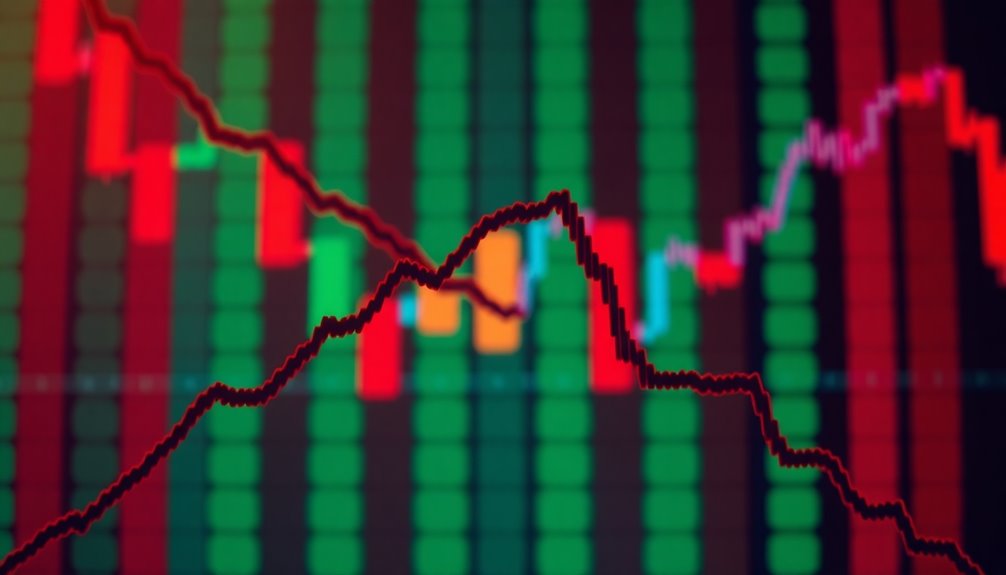A Death Cross is a key market signal that happens when the 50-day moving average dips below the 200-day moving average. This indicator often points to a potential bearish trend and suggests that market momentum is weakening. Historically, it's been associated with significant downturns in the stock market, making it a warning sign for investors. While it can effectively highlight bearish trends, you should use it alongside other indicators to avoid false signals. Understanding its context and implications can help refine your trading strategy, and there's more to explore about its significance and history.
Key Takeaways
- The Death Cross occurs when the 50-day moving average crosses below the 200-day moving average, signaling a potential bearish trend.
- Historically, the Death Cross has preceded significant market downturns, including notable events in 1929, 1974, and 2008.
- It is considered a lagging indicator, reflecting past price movements, which may lead to delayed trading decisions.
- High trading volumes during a Death Cross can confirm the bearish trend, enhancing its reliability as a market signal.
- Combining the Death Cross with other indicators, like RSI and MACD, can improve trading strategies and reduce the risk of false signals.
Key Characteristics of Death Cross

The Death Cross is a significant technical indicator in the trading world, marking a potential shift in market sentiment. It occurs when the 50-day moving average crosses below the 200-day moving average, signaling a bearish market trend.
Historically, this pattern has foreshadowed significant market downturns, especially during crises like those in 1929, 1974, and 2008. After a Death Cross, you're likely to see increased trading volume and selling pressure, confirming the bearish trend.
While it's a lagging indicator that reflects past price movements, it can lead to false signals if not supported by other technical indicators. Notably, the S&P 500 often shows gains a year after a Death Cross, with two-thirds of instances resulting in an average gain of 6.3%.
Defining the Death Cross Concept
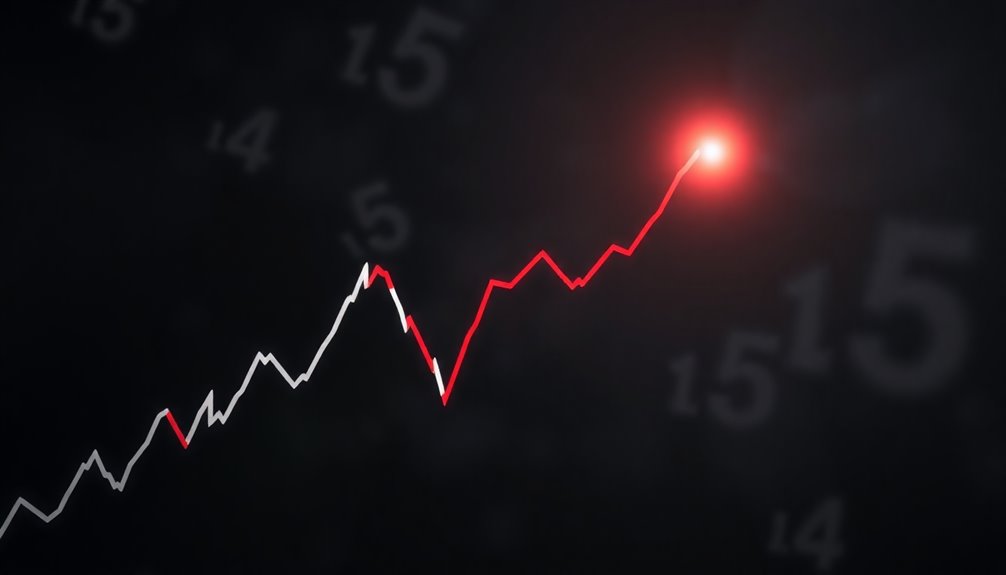
When traders observe a Death Cross, they see it as a pivotal moment in market analysis. This technical analysis indicator occurs when the 50-day moving average crosses below the 200-day moving average, signaling a potential bearish trend. It reflects a decline in short-term momentum, often interpreted as a sell signal by many.
Historically, significant Death Cross events have marked major market downturns, particularly in 1929, 1974, and 2008. As a lagging indicator, it highlights past price movements and may not predict rapid changes.
Curiously, average returns post-Death Cross for the Nasdaq suggest potential rebounds, with gains of 2.6% after one month, 7.2% after three months, and 12.4% after six months, despite the bearish signal.
Signal From Moving Averages
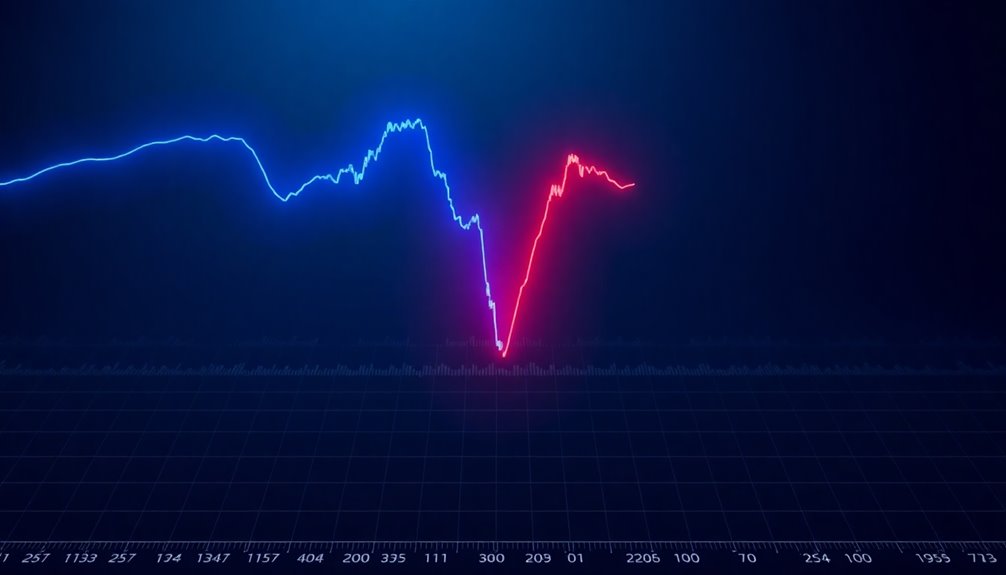
While moving averages serve as essential tools in technical analysis, they provide more than just a static view of price trends; they signal potential market shifts.
The death cross, occurring when the 50-day moving average crosses below the 200-day moving average, indicates a bearish trend. This technical indicator reflects historical patterns, often preceding significant market downturns. Remarkably, high trading volumes during a death cross can strengthen the confirmation of this trend.
Though it's a lagging indicator, you might find that two-thirds of S&P 500 instances show gains one year after, averaging 6.3%. Understanding these signals can help you navigate potential risks in your investment strategy, especially during times of volatility.
Pros and Cons of Usage

Understanding the death cross helps you weigh its advantages and disadvantages in your trading strategy.
As a reliable bearish indicator, it often signals a potential market downturn when the 50-day moving average falls below the 200-day moving average.
However, its lagging nature can lead to late trading decisions, especially in rapidly changing markets.
While two-thirds of S&P 500 instances post a gain a year after a death cross, relying solely on this indicator can result in false signals during sideways trading.
To enhance its effectiveness, consider combining the death cross with other technical indicators like RSI or MACD for better confirmation of market trends.
Balancing these pros and cons is key to effective trading strategies.
Golden Cross Versus Death Cross

The Golden Cross and Death Cross are pivotal indicators in technical analysis, each signaling contrasting market movements.
A golden cross occurs when the 50-day moving average crosses above the 200-day moving average, hinting at a bullish trend and often accompanied by increased trading volume. This pattern typically follows a downtrend, suggesting a reversal in price action. Traders often look for the golden cross as a signal to enter long positions, as the crossover indicates potential upward momentum. Utilizing a golden cross trading strategy in crypto can enhance the likelihood of capturing significant price movements while managing risk. Additionally, monitoring other technical indicators alongside the golden cross can provide further confirmation and improve decision-making in the volatile cryptocurrency market.
In contrast, the death cross happens when the 50-day moving average dips below the 200-day moving average, indicating a bearish trend. This pattern usually follows significant market losses, serving as a warning to exit or short positions.
Both market signals are essential technical indicators, guiding traders in the stock market to make informed decisions based on potential price movements.
Market Volatility Impacts Reliability
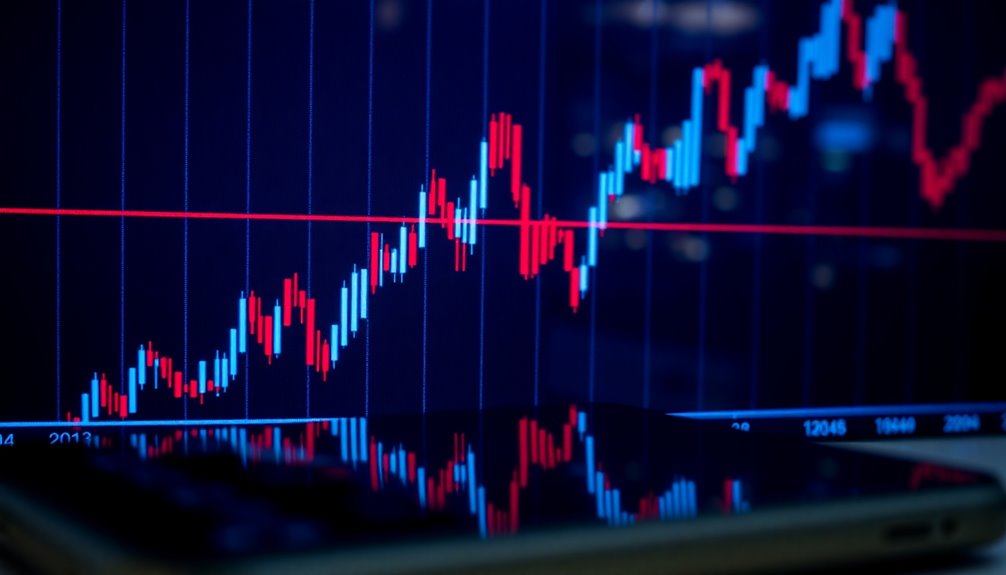
Market volatility greatly affects the reliability of the Death Cross as a trading signal. In highly volatile markets, you might experience an increased frequency of false signals, as rapid price movements can obscure underlying trends.
The lagging nature of the Death Cross often results in delayed reactions to significant shifts, making it less dependable on its own. Historical data reveals that during extreme volatility, such as the 2008 financial crisis, Death Cross signals didn't always precede sustained downturns, showcasing potential unreliability.
The effectiveness of this bearish signal diminishes in sideways markets, which can lead to erratic trading. To enhance reliability, technical analysts often seek confirmation from additional indicators during such conditions to mitigate risks associated with false positives.
Recent Market Behavior Analysis

Recent trends highlight how Death Crosses can considerably influence market dynamics. When the 50-day moving average falls below the 200-day moving average, you often see increased selling pressure and heightened volatility in the stock market.
Historical data shows that about two-thirds of S&P 500 instances experience gains within a year, averaging 6.3%. However, the reaction to these signals varies; some lead to quick market recoveries, while others result in prolonged downturns.
Significantly, recent Death Cross occurrences have coincided with substantial market corrections, like the sell-off during the COVID-19 pandemic. Increased trading volumes during these events often confirm bearish sentiment, indicating stronger investor conviction about the prevailing trend.
Understanding these patterns can help you navigate future market behaviors effectively.
Monitor Volume During Cross Signals
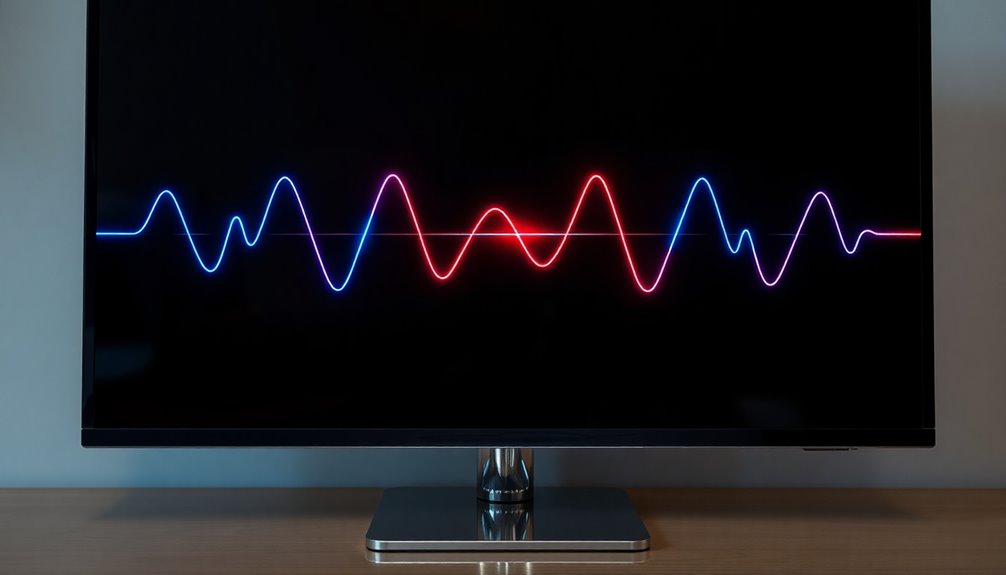
Monitoring volume during a death cross is essential for understanding the strength of the signal. High trading volume accompanying a death cross can confirm the bearish trend, indicating that more investors are selling, which amplifies downward momentum.
Historical data shows that death crosses followed by significant volume often lead to pronounced price declines, reinforcing the reliability of the signal. Conversely, if a death cross occurs with low volume, it might suggest a lack of conviction among traders, hinting at a potential false signal.
Frequently Asked Questions
Is Death Cross Good or Bad?
Whether the Death Cross is good or bad really depends on your perspective.
It often signals potential market declines, which can evoke fear and prompt selling. However, history shows that many stocks recover over time, with gains following a Death Cross.
If you're an investor, it's essential to take into account other factors and not rely solely on this indicator.
Keep an eye on market trends and remember that opportunities can arise even in negative signals.
What Happens After a Death Cross?
When the market hits a rough patch, you might find yourself wondering what comes next.
Typically, after a death cross, you'll see increased selling pressure and market volatility. However, don't throw in the towel just yet!
Historical data shows that about two-thirds of S&P 500 instances see gains within a year.
What Is the Cross of the Dead?
The phrase "cross of the dead" often refers to a significant shift or change, usually in a spiritual or metaphorical sense.
It symbolizes moments when you confront mortality or the end of a significant phase in life. This concept encourages reflection on life choices, urging you to embrace transformation and renewal.
When you face such a crossroad, it's crucial to recognize the opportunities for growth and understanding that can arise from these pivotal experiences.
What Is the Death Cross in Bitcoin?
You might feel a thrill watching Bitcoin soar, but when the 50-day moving average dips below the 200-day, it's a warning sign.
This "death cross" often signals a bearish trend, making many traders nervous. While it reflects past performance and can amplify selling pressure, don't lose hope.
Historical data shows that, after this event, Bitcoin often stabilizes or even rebounds in the coming months, offering potential gains for savvy investors.
Conclusion
To conclude, understanding the death cross can help you navigate market trends and make informed decisions. For instance, imagine you notice a death cross forming on a tech stock you own. As the 50-day moving average dips below the 200-day, you decide to sell before potential losses mount. This proactive approach not only protects your investment but also positions you to reinvest when the market rebounds, showcasing the importance of monitoring these signals closely.
